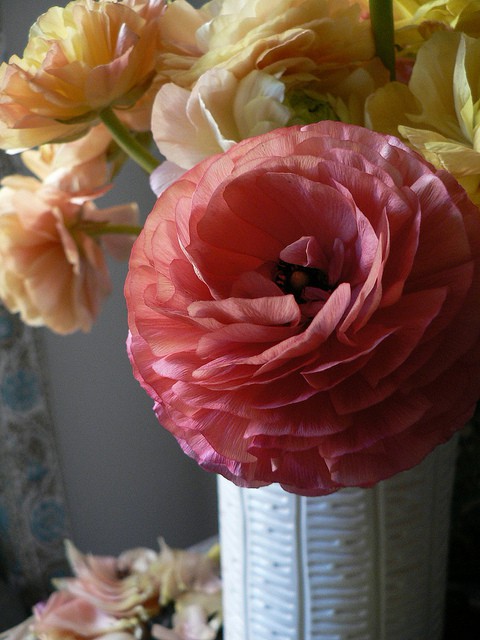- Planting Ranunculus In Fall
- Planting Ranunculus Bulbs
- Planting Ranunculus In Spring
- Planting Ranunculus Tubers
- Planting Ranunculus Zone 7
Fall is the Time to Plant Ranunculus
Planting Ranunculus in the Garden. Plant ranunculus in early to mid fall in zones 8 through 10 and in early spring after all threat of frost has passed in zones 1 through 7. Choose a spot in full sun with well-drained soil. Place near other spring blooming flowers like snapdragons, larkspur or tulips.
Plant ranunculus tuberous roots now and you won’t have to wait to find plants in late spring. The other advantage of buying tuberous roots from a nursery or online seller is that you can locate the color you want. Even better, ranunculus roots are about 1/5 the price of a full plant. The bloom options are wide and varied, so the biggest problem you’ll have is deciding on just a few! I saw a pink/salmon variety called ‘Elegance Salmon’ which touts disease resistance, longer stems, and bigger blooms. This one had me at the picture. I ordered a package of 5 bulbs which cost around $10 with the early order discount.
Where to Plant Ranunculus
If I don’t write down where I’m going to plant things at the time I order them, I forget where I planned to place them. When these beauties arrived, it took longer to select the right spot than to plant them! I was lucky to have received six bulbs in the package instead of the five I ordered. That allowed me to put five in a prepared bed around my patio that receives 6+ hours of sun, and one in a container so I could locate wherever I needed color in the spring.
To plant these, you’ll need your gloves, a hand trowel and a watering can to get these planted.
Ranunculus have tuberous roots
Planting Ranunculus In Fall
Locate a spot with at least 4 hours of sun and well-draining soil. Planting ranunculus is easy because you only need a planting depth of two inches. Lay out the bulbs keeping them 4-6 inches apart and then place the bulb in the hole with the spiky roots downward. Cover with soil and water in well.
Planting Ranunculus Bulbs
- Even though a cutting-garden plant is often a cut-and-come-again type, meaning cutting stimulates more growth, planting extra ranunculus to cover the “holes” left by cutting is a good idea. Then the overall design of the bed isn’t affected by the missing cut-flowers.
- Plant jumbo ranunculus tubers one to two inches deep and eight to 12 inches apart in a well-draining location in full sun with the claw pointing downward. Zones 8 to 11 should plant between October and November. Ranunculus can be started in cooler regions in the spring one to two weeks before the last predicted frost.
- For outdoor landscape planting, dig holes and set your Ranunculus bulbs 2–3' deep and 4–6' apart. Cover the bulbs with soil and water thoroughly. For container planting, set your Ranunculus 2' deep and 3–4' apart in good-quality, well-draining potting soil (not garden soil).
Care and Maintenance
After planting, be sure to mulch around the area to keep the bulbs moist and protect from the winter chill. Once you’ve watered the bulbs in, leave them alone as the roots don’t like being disturbed. There is no need to water again until you see the foliage begin to sprout in the spring, and then keep the plants evenly moist. In most cases, our spring showers are sufficient to ensure blooms, but you may have to augment if our spring is particularly dry.
Ranunculus Make Great Cut Flowers
Ranunculus appear in April-May and are such pretty flowers you may want some to remain in the garden, while also enjoying a few in the house. The good news is the more you cut the blooms, the more blooms the plant will produce – so cut away! In fact, this is a plant you want to deadhead, or cut off spent blooms to encourage new blooms.
Ranunculus stems will last up to 10 days in a vase. The trick is to cut the flower stem when you see the bud just begin to open or show color. Remove any leaves that would be below the water line to avoid bacterial growth that can shorten the lifespan of a stem. Once in the house, trim the stem again and put immediately into the vase. Ranunculus stems can reach one to two feet tall, so you have plenty of length to work with. It’s best to change the water in the vase every two to three days to keep the water fresh.
Naturalizing Ranunculus
Best suited for zones 8-10, Austin is a great location to naturalize Ranunculus bulbs. As with all bulbs, allow the foliage to yellow and die back before cutting, as this allows the foliage to feed the bulb for next year’s blooms. Since the foliage goes fully dormant during the summer, no additional watering is necessary and if located in an area with excessive water, the bulb can rot. If in a container, refrain from watering after the bulb has gone dormant and put it away until next spring. Whether you decide to keep your Ranunculus in a container or in the ground, I suspect you will become hooked and want to try more varieties and colors year after year.
Planting Ranunculus In Spring

Planting Ranunculus Tubers
Additional Resources
Planting Ranunculus Zone 7
Yvonne was a 35+year veteran in the computer and information technology industry when she retired and moved from Houston to the Austin area. In 2018, Yvonne certified as a Travis County Texas Master Gardener to follow her passion for gardening and volunteering within the community. She has spent 20+ years enjoying gardening and working with bulbs and perennials. She now tackles the challenges presented by the Austin area wildlife, drought, and limestone soil.
